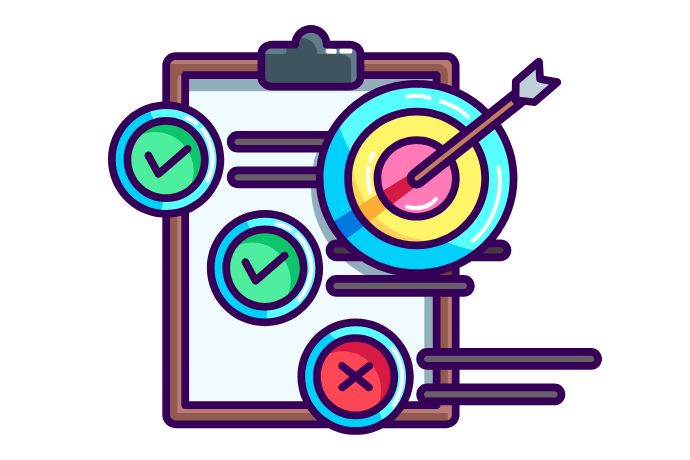Outcomes and Objectives - A Path to Success

By Tim Whiting
“When it comes to teaching, one of the most fundamental steps in crafting an effective lesson plan is setting clear learning objectives. These objectives act as a roadmap for both the teacher and the student, guiding the direction of the lesson and helping to assess the outcomes.” (Kumar, 2025)
It is important to communicate to our students what our expectations are and what skills they will need to master and demonstrate to be successful. They need to know what will take them to the next level in their desired career. This is achieved through the implementation of clear learning outcomes and learning objectives when developing our courses.
Within instructional design, we often overlap such terms as “course objectives", "course goals", “learning objectives,” “learning outcomes,” and “learnings goals.” For clarification, we will focus on course learning outcomes, learning objectives, and program goals. Through this article, we will provide definitions of each, explain how they connect to each other, and how you, as the instructor, can effectively use them in your course.
Understanding “Understanding by Design”
No matter the course or the content, our overall goal is student learning and student achievement. A natural approach when we start to think about a new course that we are developing is to think about the activities we want students to participate in and the products we want them to produce. The more effective approach lies in the process of Backwards Design or Understanding by Design. This approach, originated by Wiggins and McTighe (1998) is based on the idea that “faculty typically design their courses around a set of activities and content first (forward design), and then try to connect those activities to learning goals of their course. Often this is a forced fit, artificial at best and completing missing the mark at worst” (Caruana, 2019). Instead, start with the end in mind. By knowing what the finish line (learning outcomes) looks like, you can design the route (learning objectives). By knowing the final goal and outcome, you can plan the steps (lessons, assignments, assessments) to get there.
Know the Program Goals
Let’s start at the top. Each course is part of a larger program. This might be an extensive program with a major focus that has already been implemented at the university level, or this may be a smaller minor or certification program that you are currently developing. Either way, there are a series of courses that make up the program. Therefore, the overall program needs to have established goals that are accomplished through the completion of the specified courses. The program goals that are connected to your specific course are connected to your course learning outcomes in your syllabus and should include a basic description. If you are unsure of your program goals, contact your program lead or dean for access to the program goals, and engage in a conversation to clarify the goals that this specific course will accomplish.
Course Learning Outcomes (CLOs)
An “outcome” is defined as “the results measured at the end of a unit, course, or program” (Orr et al., 2022). The CLOs provide guidance and the end result of what is learned through the course. A typical semester credit course (whether it is 15 weeks or 7 weeks; whether it is face-to-face, hybrid, or online) benefits from between 3 to 5 CLOs that are aligned with the program goals. These are stated in the course syllabus to provide students with guidance from day one. They are then referenced throughout the course when specific learning objectives, assessments, and projects link to them.
Learning Objectives (LOs)
To achieve the CLOs, students complete the lessons within the course. Within those lessons are embedded learning objectives (LOs), “a declarative statement that identifies what students are expected to know and do” (Orr et al., 2022). If a module system of learning is used, learning objectives may be referred to as Module Learning Objectives (MLOs). This is common in online learning. Depending on the lesson, 2-5 learning objectives are relevant. By meeting the learning objective, the student is reaching toward the larger course learning outcome. The connection between the LO and the CLO should be made directly within the lesson and within the specific assignment, discussion board, assessment, or project to demonstrate that the student has mastered the learning objective. Rubrics should be designed to connect the students’ mastery to the learning objective.
Bloom’s Taxonomy
Before moving into actually developing and writing outcomes and objectives, let’s learn the language. When establishing the “finish line,” we must think about where we want that finish line to be. If it’s too close, the students are not challenged and will not be challenged in the future. If we put it too far, they will have a hard time seeing it and understanding how they can accomplish it, leading to a sense of giving up or failure. We need to find the balance and set a clear goal, and this is where Bloom’s Taxonomy comes in. Originated in 1956 by Dr. Benjamin Bloom, this framework’s “core purpose was to ensure that learning transforms into higher levels of thinking, rather than a mere act or process of remembering the facts in a well-defined structure” (Irfan Hyder & Bhamani, 2016). Bloom’s Taxonomy establishes seven orders of learning, and within each, actionable verbs determine the path to achieving the goal (Refer to Figure 1)
-512x416.png)
Preville, P. (n.d.-a). The Professor’s Guide to Using Bloom’s Taxonomy [Book]. In tophat.com.
https://tophat.com/wp-content/uploads/Blooms_taxonomy_FINAL.pdf
Writing Objectives
The same process is used when writing an outcome or an objective. In essence, you are writing a statement that establishes what is expected of the student once they complete the learning cycle (the lessons, the readings, the assignments, the assessments, etc...).
-
Think about what the overall goal is (ex/to think critically through writing).
-
Think about what you want your students to learn to accomplish that goal (ex/write an expository essay).
-
Determine which of the seven orders of learning students need reach to show mastery of the content (ex/ For a high learning level with writing, you want to focus on at least the analyze level as it will push students to think critically and go above basic understanding).
-
Determine the actionable verb(s) that will connect to the order of learning (ex/ explore, examine, differentiate). For a list of actionable verbs common in Bloom’s Taxonomy, refer to Figure 2.
-
Write the objective, leading with the actionable verb and establishing the outcome of the objective (ex/Students will be able to critically analyze complex informational sources, synthesize diverse perspectives, and construct a coherent, well-organized expository essay that effectively communicates nuanced ideas with clarity and precision).
Figure 2
-845x647.png)
As you are writing your learning objectives, keep these simple suggestions in mind:
-
Objectives should identify a learning outcome.
-
Objectives should be consistent with course/program goals. When objectives and goals are not consistent, two avenues of approach are available: change or eliminate the objective or change the course goal.
-
Objectives should be precise. It is sometimes difficult to strike a balance between too much and too little precision in an objective. There is a fine line between choosing objectives that reflect an important and meaningful outcome of instruction, objectives that trivialize information into isolated facts, and objectives that are extremely vague.
(Caruana, 2019)
I’ve got my objective, now what?
You have determined your learning objectives. You know how they connect to your learning outcomes (which connect to the program goals). Now, what do you do with them?
Learning objectives can be used to guide your lessons. As a lesson is built, the starting point is the learning objectives. Once you establish what the result of that specific lesson is, you can build the readings, lectures, and assignments to meet the objective, wrapping it up with an assessment the measures the students’ mastery of the concepts. Throughout the lesson, it is important to communicate the learning objectives to the students. This will help them connect the tasks that they are completing with the objectives, establishing rationale for what they are learning. The learning objectives are measured by being connected to assignments and assessments within the lesson. If students accomplish the assignment or assessment to the highest level, they have met the objective.
Well, then, how do you determine if they met the objective through the assignment or assessment? With a well developed and implemented rubric, of course. A rubric that falls in line with the learning objective has already been developed and established prior to the student completing the assignment or assessment. When you are grading the assignment or assessment using a rubric, you can determine the level to which the student has met mastery.
Conclusion
If students do not know the finish line, they cannot reach it. Creating well thought out learning outcomes and learning objectives informs the student where the finish line is and helps to make the route clear. Communicating these objectives to students creates a path to success.
References
Caruana, V., PhD. (2019, June 24). Designing Meaningful and Measurable Outcomes: a first step in backwards design. Faculty Focus | Higher Ed Teaching & Learning. https://www.facultyfocus.com/articles/course-design-ideas/designing-measurable-outcomes-with-backwards-design/
Irfan Hyder, S., & Bhamani, S. (2016). Bloom’s Taxonomy (Cognitive Domain) in Higher Education Settings: Reflection brief. Journal of Education and Educational Development, 3(2), 288. https://www.researchgate.net/publication/314968444_Bloom's_Taxonomy_Cognitive_Domain_in_Higher_Education_Settings_Reflection_Brief
Kumar, P. (2025, May 30). Setting Learning Objectives: A Guide for Effective Teaching • Teachers Institute. Teachers Institute. https://teachers.institute/instruction-in-higher-education/setting-learning-objectives-effective-teaching/
Mathur, H. D. (2017). Blooms Taxonomy Action verbs. www.academia.edu. https://www.academia.edu/30977954/Blooms_Taxonomy_Action_Verbs
Orr, R. B., Csikari, M. M., Freeman, S., & Rodriguez, M. C. (2022). Writing and using learning objectives. CBE—Life Sciences Education, 21(3). https://doi.org/10.1187/cbe.22-04-0073
Preville, P. (n.d.-a). The Professor’s Guide to Using Bloom’s Taxonomy [Book]. In tophat.com. https://tophat.com/wp-content/uploads/Blooms_taxonomy_FINAL.pdf
Wiggins, G., & McTighe, J. (1998). Understanding by design. Alexandria, VA: Association for Supervision and Curriculum Development.







